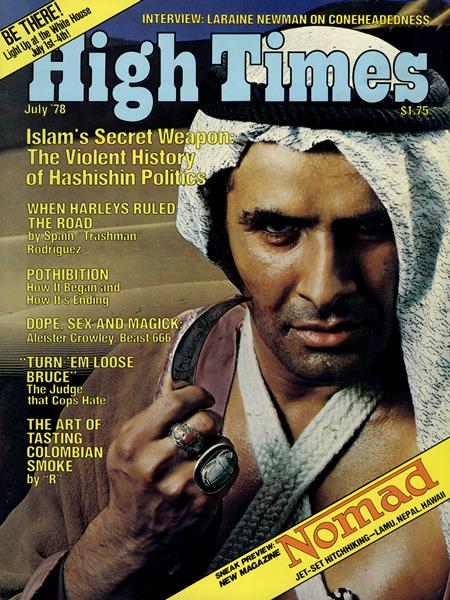Not far from the coast of Kenya in the iridescent Indian Ocean lies an island called Lamu, very much the same as it was a thousand years ago. Since time out of mind, Lamu has been a bustling entrépot of the African-Arabian trade, its wharves aswarm with dhows freighting ostrich feathers, elephant tusks and green hashish, its bazaars awash with every exotic skin tone from Tibetan gold to Zulu ebony. And in recent years, gliding inconspicuously in their shimmering wraparound kikoys among all these motley traders, an increasing number of Western adventurers have been living out fantasies straight from the Arabian Nights.
For a dollar a night, boarding houses in Lamu town will afford a visitor not merely clean lodgings but access to the flat roof with unlimited sunset-watching and stargazing privileges. Lamu marijuana is cheap and powerful, restrictions against it are minimal, and the African equatorial heavens are spectacular and infinitely absorbing. Thus many are persuaded to stay for months on end, renting ancient high-walled townhouses for $20 to $50 a month.
The traditional Swahili ambiance of Lamu town thrives at the 200-year-old Petley’s Inn, complete with first-class bar and restaurant and pool, yet blending perfectly with the island’s unique tranquility and magnetism. Automobiles are banned from Lamu’s narrow streets, constructed to shade the people from the equatorial sun and to generate refreshing sea-wind currents. Transporation is by foot and donkey mainly, or by m’tabi, a sturdy Swahili motorboat with a swan’s curve belly and bow. Every jetty and marketplace is lined with shops decorated with brilliant banners and awnings, the owners and customers alike wearing long white khanzu-robes and fezlike kofias. Business is brisk and noisy in the morning and picks up again toward sunset, after the long afternoon doze.
Thus life stirs early in Lamu, with the predawn muezzin prayer calls ululating fluidly from the island’s 22 mosques. The men go to pray, while the women in their black habitlike bui-buis begin breakfast. For a visitor, wandering about Lamu at any time of day is like a translation into another time, and especially so at dawn and dusk. Thursday evening, the eve of the Muslim Sabbath, is celebrated abroad from every mosque with the hypnotic Sufi music of drums, tambourines, flutes, hymns and chants. The same joint partaken to enjoy the sunset will carry one irresistibly through the musical Oriental streets, haunted with immemorial genies and houris.
It is the gentle mystical tradition of Sufi that lends Lamu its ageless Islamic atmosphere. “We have a different sense of time here,” explains M’zee Selim Ahmed, a 60-year-old Lamu shaykh. “We know that we live in a paradise, and we want to continue to cherish the timeless values we hold to our hearts.”
Lamu town itself dates from the first provenance of itinerant Sufi preachers, who 700-odd years ago settled Somalia, Kenya and Tanzania. The intervening centuries blended the Bantu and Arabian languages and cultures into modern Swahili, a wildly cosmopolitan culture deeply infused with the tolerance and illumination of Sufi Islam.
The Sufi influence accounts for the benign official attitude toward qunnab (hemp) on Lamu and for the exceptionally liberated condition of its womenfolk, virtually unique in all Islam. While the bui-bui is still worn everywhere, Lamu women typically allow the veil to slip after dark, revealing smoky black eyes and bright African fabrics underneath. Virginity is still expected of very young brides, but older girls having once “dallied” are suprisingly free to have lovers. Marriage is no absolute totem on Lamu, where adultery and divorce are almost fashionably commonplace. Polygamy is allowed for men, but rarely practiced due to its expensiveness; and the women are virtually into serial polygamy, many 25-year-old girls having four or five divorces behind them.
Yet the Islamic society on Lamu is as tight and cohesive on every level, from family to government, as any small American town in the 1900s. This proceeds naturally from the communal prayers, fasts and festivals of Sufi Islam, so that a kind of homely holiness pervades the entire island. Visitors with a sincere interst in studying Sufi and Swahili discover themselves welcome in Lamu households, and the shaykhs take great pleasure in instructing Western tourists.
And always there’s the beaches, particularly the eight-mile stretch of surfside sand near Shela, a village populated mainly by devoted dope smokers. Hot and windy the year round, the climate is terrific for swimming, fishing and sailing, and at Shela’s luxurious Peponi Hotel one can order anything from malt beer to lobster thermidor. But the cardinal attraction for any pilgrim to Lamu occurs every 28 days, when the full moon swells up yellow out of India over the ocean, and dope smokers from all East Africa salute it from Shela Beach through a rising ghostly mist of communal cannabis.
Who knows? You might find yourself passing a long-handled hash pipe between Richard Burton and the Khalif Haroun al-Raschid. Or merely giggling like crazy with a very attractive sunburned fellow pilgrim from Kalamazoo or Copenhagen. And here you all are in Lamu.

Read the full issue here.
